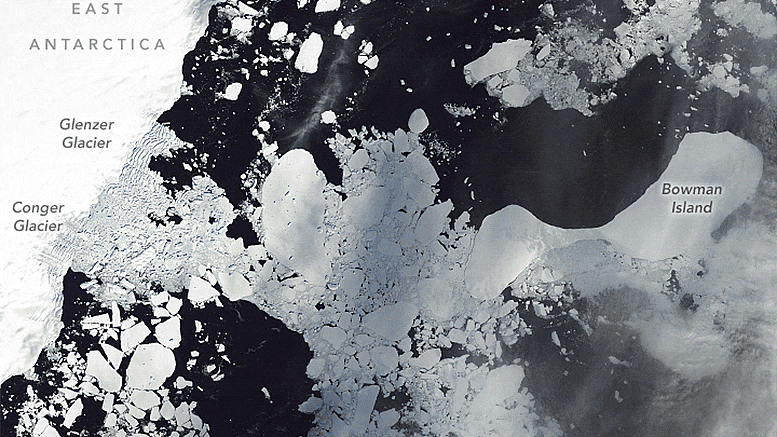
Ice Shelf Collapse in East Antarctica
The shelf’s disintegration in March 2022 has reshaped a landscape where coastal glacial ice was once thought to be stable.
It is relatively common for ice shelves in Antarctica to spawn icebergs. It is less common for an ice shelf to completely disintegrate. In March 2022, an ice shelf in East Antarctica did both. The collapse has reshaped a part of the Antarctic landscape where coastal glacial ice was once thought to be stable.
The change happened fast. At the start of March 2022, the floating shelf fed by the Glenzer and Conger glaciers was still intact. By the middle of the month, it had fallen apart. This image pair (above), acquired by the Operational Land Imager (OLI) on Landsat 8, shows the shelf before and after it disintegrated.
“The whole shelf collapsed in just around two weeks,” said Christopher Shuman, a University of Maryland, Baltimore County, glaciologist based at NASA’s Goddard Space Flight Center. The icy remnants of both glacial shelf ice and adjacent sea ice dispersed from the waters around Bowman Island within weeks. “All of this took less than a month,” Shuman said. “It was quite the blowout.”
The progression of the collapse is visible in the image series above. Images were acquired with the Moderate Resolution Imaging Spectroradiometer (MODIS) on NASA’s Terra and Aqua satellites.
The first image shows the ice shelf floating on the Mawson Sea on February 22, 2022, prior to the collapse. Fast ice—a type of sea ice that becomes “fastened” to the edges of ice shelves, coastlines, and icebergs—is also part of the mix. For two years prior to this image, the shelf was already in a state of decline. According to Catherine Walker of the Woods Hole Oceanographic Institution, the shelf was losing ice at an average rate of about 1 square kilometer per day through the natural process of iceberg calving.
But in early March 2022, the shelf in front of the Glenzer Glacier calved a substantial iceberg. Named C-37, the berg initially measured about 144 square kilometers (56 square miles). A few pieces broke off, such that C-37 measured about 81 square kilometers on March 12 when MODIS acquired the second image in the series. The substantial loss of ice meant the shelf disconnected from Bowman Island. (Note that some sea ice remained attached to the island.)
“Without being supported by a land anchor, the ice shelf was destabilized and primed to collapse,” said Jonathan Wille, a postdoctoral researcher at the Université Grenoble Alpes.
According to Wille, an atmospheric river on March 15 appears to have triggered the shelf’s final collapse. The weather system—which caused temperatures in eastern Antarctica to soar 40 degrees Celsius above normal—also enhanced ocean swells and amplified winds near the vulnerable shelf. This likely caused the ice in front of Conger Glacier to break apart and quickly disperse.
The third MODIS image above shows the area on March 16 after the final collapse. The event spawned Iceberg C-38, which at the time measured about 415 square kilometers (160 square miles). The final image in the series shows the crumbled shelf ice and fast ice as it dispersed in the sea on March 21.
The loss of an ice shelf is problematic because it can indirectly contribute to sea level rise. “Ice shelves are essentially the ‘safety band’ holding up the rest of the Antarctic Ice Sheet,” Walker said. When they collapse, the ice behind them can more quickly flow into the ocean. “And that is what raises sea levels.”
By Antarctic standards, the ice shelf and glaciers that it held back are relatively small, so the impacts from the collapse are expected to be minimal. Scientists are more concerned about the location of the collapse.
“All of the previous collapses have taken place in West Antarctica, not East Antarctica, which until recently has been thought of as relatively stable,” Walker said. “This is something like a dress rehearsal for what we could expect from other, more massive ice shelves if they continue to melt and destabilize. Then we’ll really be past the turnaround point in terms of slowing sea level rise.”
NASA Earth Observatory images by Lauren Dauphin, using Landsat data from the U.S. Geological Survey and MODIS data from NASA EOSDIS LANCE and GIBS/Worldview.

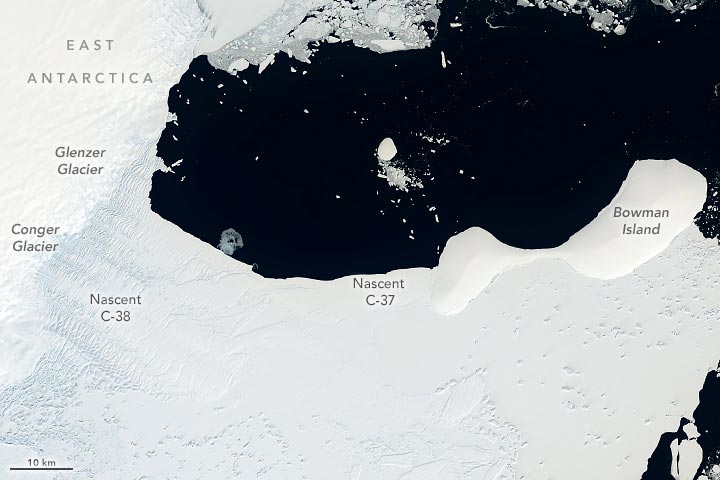
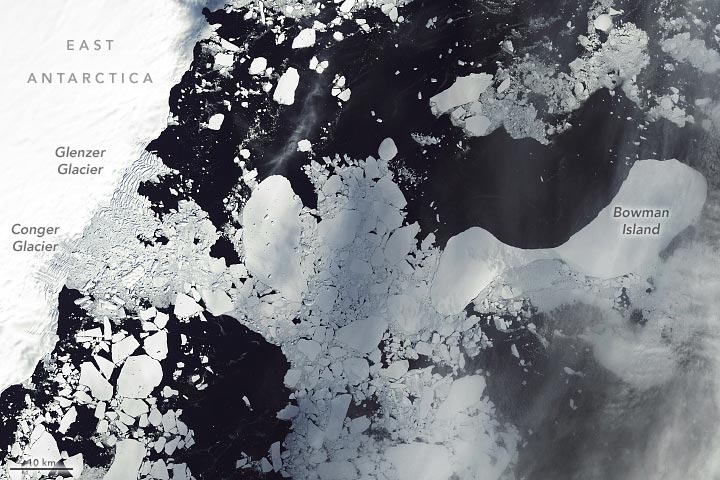
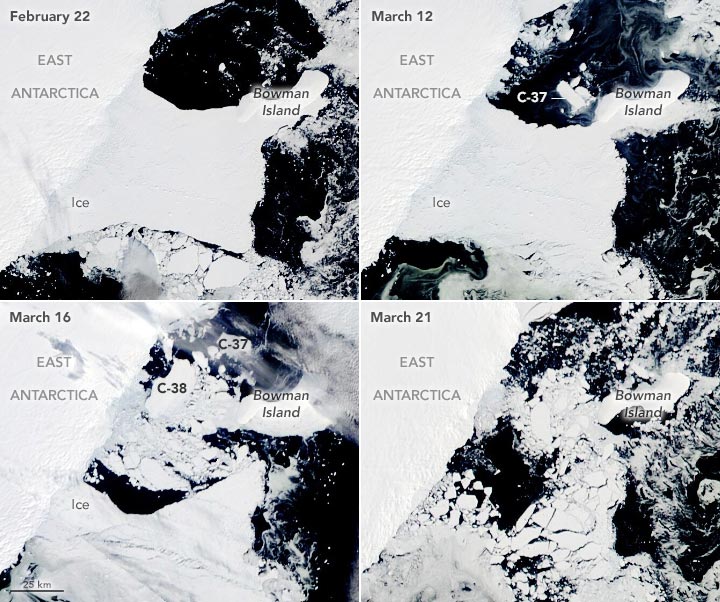
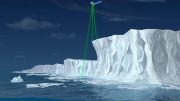







“Ice shelves are essentially the ‘safety band’ holding up the rest of the Antarctic Ice Sheet,” Walker said. When they collapse, the ice behind them can more quickly flow into the ocean.”
If the ice shelves are resisting the flow of the glaciers, then they would be under compressive stress. The description of the breakup sounds more like the shelf broke apart along multiple tension cracks. Were there any unusually high or low tides? Come back in a year and tell us if the two glaciers speeded up.
The Earth’s climate has been changing ever since the Earth formed. We’re currently in the interglacial phase of an ice-age, and the temperature – and the sea level – has been increasing rather consistently since the end of the last glaciation, about 10,000 years ago. In the past 4000 years alone, the Minoan, Roman, and Medieval warm periods were warmer than today, and the Medieval and Maunder Minimum cold periods were much colder. There is no evidence to show that the paltry amount of Carbon Dioxide that we put into the atmosphere has any substantial effect on climate; what can be demonstrated is that it makes plants grow better, especially food crops!
The entire “Anthropogenic Climate Change” debate is purely political and is based on computer models which have never been validated, indeed have been shown to be wrong. Wrecking our economy in order to attempt to change the course of the Earth’s climate is a self-destructive exercise in futility.
I am curious how much the fossil fuel industry is paying you to troll the news media and promote their agenda. I have spent too many thousands of hours researching climate change to be fooled by your fanciful retoric.
Were it possible to interview the former inhabitants of Doggerland, I am sure that they’d affirm Mr Blase’s remarks insofar as rising sea levels are concerned:
“At the end of the last ice age, Britain formed the northwest corner of an icy continent. Warming climate exposed a vast continental shelf for humans to inhabit. Further warming and rising seas gradually flooded low-lying lands. Some 8,200 years ago, a catastrophic release of water from a North American glacial lake and a tsunami from a submarine landslide off Norway inundated whatever remained of Doggerland.”…National Geographic
You don’t have to talk to dead people from the past to understand what the geologic history is showing us. What it is showing us is that never in history has climate change occurred as quickly as today, with the exception of meteor strikes or large scale volcanic activity, which we are not going through at the moment
I love reading the replies above from more advanced minds (I’m a chemistry nerd). Those 3 comments above provide enough seed of doubt alone to combat the authors of related articles claiming this is profound and that sea level rise (from a relatively thin and small area) could be catastrophic for the world. What’s the word…? Oh yes, audacious.
What is audacious is you claiming that climate science only includes the area represented in this article when referring to sea level rise. Your just another troll paid by the fossil fuel industry.
My guess is that the commenters here are financed by the fossil fuel industry, as their statements are contrary to 99 percent of scientists worldwide. The coming climate catastrophe and loss of life is something they will take to their grave. Stymying green energy transitions are a crime against humanity greater than any other since man has walked the earth. You can’t take oil$ with you when you die, but your actions will stay with you forever.
It is called a shelf, melting from underneath. There are 2 active valcanos in Antartica. Maybe that is why it is melting from underneath and they have underground river
Not climate change. Media wrote article which was very misleading. Antartica was 60 degrees warmer. It was -10 to -70 degrees
The sky is falling! These glaciers as all before them will melt, collapse and break off. It has happened many, many, times before and will keep happening. Been predicting catastrophic costal flooding for decades with very poor accuracy. Ocean levels rise and fall have little to do with man, cycles in the oceans take up to 100 years for warming and cooling to manifest.
Human arrogance is the bigger problem, believing we are more powerful or vital to the cycles and behavior of the planet then we really are. There is so much about this planet we are so ignorant about (much of it underwater), interactions and processes we barely know about or understand. So much belief in highly inaccurate computer climate simulations and predictions of future climate conditions all assuming warming is a indefinite constant.